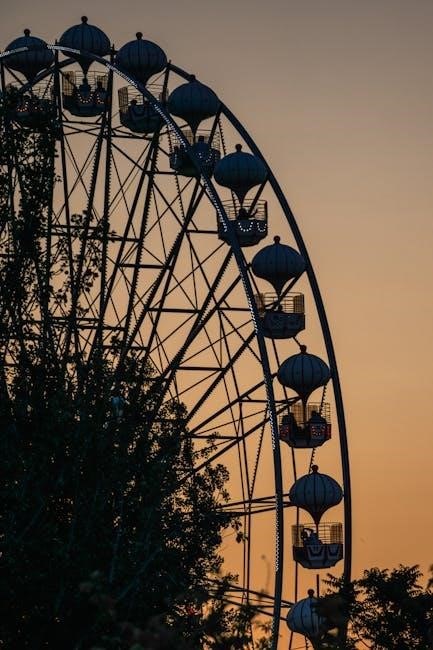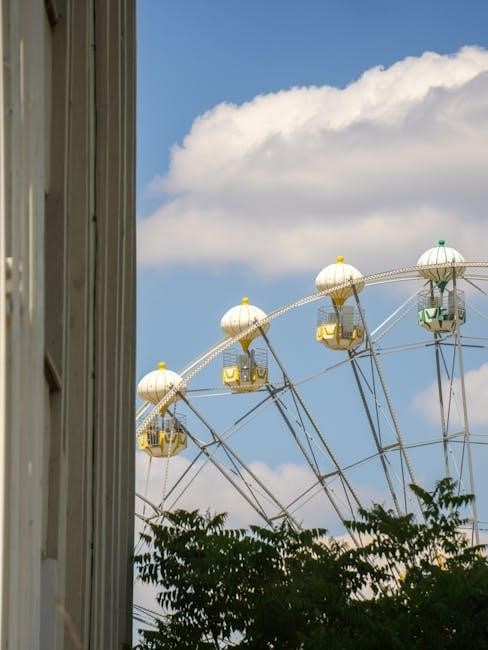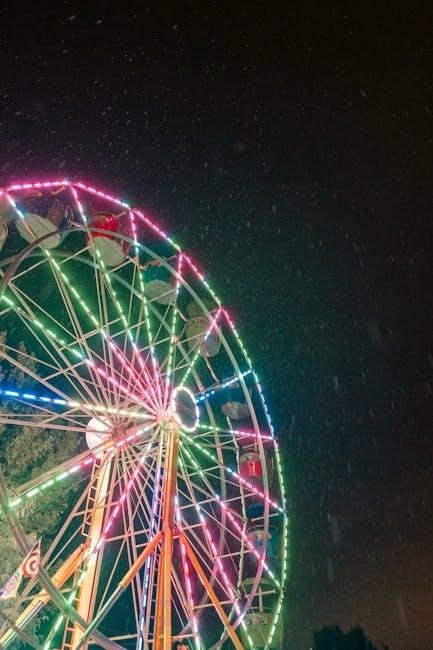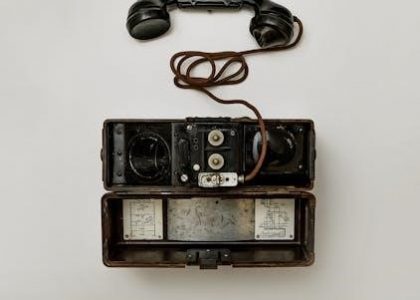Paul Revere’s Midnight Ride was a pivotal event on April 18‚ 1775‚ marking the start of the American Revolution․ PDF resources detail his historic journey․
1․1 The Historical Event and Its Significance
Paul Revere’s Midnight Ride on April 18‚ 1775‚ was a pivotal moment in American history‚ warning colonists of approaching British troops․ This bold act of defiance sparked the Battles of Lexington and Concord‚ igniting the American Revolution․ The ride symbolized courage and unity‚ highlighting the colonists’ determination to resist British rule․ Revere‚ along with William Dawes and Samuel Prescott‚ risked everything to alert the Patriots‚ ensuring they were prepared․ This event became a cornerstone of American folklore‚ embodying the spirit of rebellion and freedom․ Its significance endures‚ reminding us of the power of swift action and collective resolve in shaping a nation’s destiny․
1․2 The Purpose of the Midnight Ride
The primary purpose of Paul Revere’s Midnight Ride was to warn American Patriots in Lexington and Concord of the approaching British Army․ British forces aimed to seize colonial munitions and capture key Patriot leaders‚ Samuel Adams and John Hancock․ Revere and other riders‚ including William Dawes and Samuel Prescott‚ were dispatched to alert the colonists‚ ensuring they could prepare for battle․ This urgent mission was crucial for mobilizing the militia and safeguarding their supplies․ The ride not only served as a warning but also galvanized colonial resistance‚ setting the stage for the Battles of Lexington and Concord and the start of the American Revolution․

Paul Revere’s Midnight Ride in Henry Wadsworth Longfellow’s Poem
Henry Wadsworth Longfellow’s 1861 poem immortalized Paul Revere’s ride‚ transforming him into a national hero․ The poem’s vivid imagery and rhythmic style captivated readers‚ ensuring Revere’s lasting fame․
2․1 Publication and Popularity of the Poem
Henry Wadsworth Longfellow’s poem‚ Paul Revere’s Ride‚ was first published in 1861 in the Atlantic Monthly․ Its vivid imagery and patriotic themes resonated deeply‚ making it an instant classic․ The poem’s rhythmic style and dramatic portrayal of Revere’s journey captivated readers‚ elevating Revere to a national hero․ Its popularity endured‚ shaping public perception of the Midnight Ride and Revere’s role in American history․ The poem’s success can be attributed to its ability to blend history with artistic flair‚ ensuring its place in American literature and folklore․
2․2 Key Themes and Imagery in the Poem
Longfellow’s Paul Revere’s Ride is rich in themes of patriotism‚ urgency‚ and heroism․ The poem’s imagery vividly captures the midnight journey‚ with phrases like “the midnight ride of Paul Revere” and “the somber woods and darkened land․” The use of onomatopoeia‚ such as “the clatter of hoofs on the village street‚” immerses readers in the action․ Symbolic elements like the lantern in the Old North Church tower represent the call to action and unity among the colonists․ These themes and images not only convey the historical significance but also evoke a sense of national pride and revolutionary spirit․
2․3 The Poem’s Role in Shaping Revere’s Legacy
Henry Wadsworth Longfellow’s poem catapulted Paul Revere to national fame‚ transforming him into an iconic figure of the American Revolution․ Before the poem‚ Revere was a respected local hero‚ but Longfellow’s vivid narrative made him a symbol of patriotism and bravery․ The poem’s publication in 1861 coincided with a growing interest in American history‚ further cementing Revere’s legacy․ By focusing on the midnight ride‚ Longfellow overshadowed Revere’s other contributions‚ creating a lasting image of him as the embodiment of revolutionary spirit․ This portrayal has endured‚ making Revere one of the most recognizable figures in American history‚ largely due to Longfellow’s poetic tribute․

The Historical Context of the Midnight Ride
The Midnight Ride occurred on April 18‚ 1775‚ amid rising tensions between British authorities and American colonists‚ marking a pivotal moment in the American Revolution․

3․1 The Events Leading Up to April 18‚ 1775

Tensions between British authorities and Massachusetts colonists escalated in early 1775․ The British planned to seize colonial munitions stored in Concord‚ leading Patriots to prepare a response․ Paul Revere and other messengers were tasked with warning local leaders Samuel Adams and John Hancock of impending British troops‚ setting the stage for the Midnight Ride․ These events culminated in the Battles of Lexington and Concord‚ marking the start of the American Revolution․ PDF resources provide detailed accounts of these pre-revolutionary developments‚ offering insights into the strategic planning and urgency surrounding Revere’s mission․ This period was crucial in shaping American history;
3․2 The Ride Itself: From Boston to Lexington
On the night of April 18‚ 1775‚ Paul Revere‚ accompanied by William Dawes and later Samuel Prescott‚ embarked on a perilous journey from Boston to Lexington․ Their mission was to warn colonial leaders Samuel Adams and John Hancock of the approaching British troops․ Riding swiftly through the dark countryside‚ they alerted local militias and residents‚ spreading the famous cry‚ “The British are coming!” Revere and Dawes were briefly detained by British soldiers but managed to escape‚ while Prescott completed the ride to Concord․ This daring effort ensured the colonists were prepared‚ leading to the Battles of Lexington and Concord․ PDFs detail this historic ride․
3․3 The Immediate Impact on the American Revolution
Paul Revere’s Midnight Ride played a crucial role in sparking the American Revolution․ By warning colonists of the British troops’ approach‚ Revere enabled the militia to prepare and confront the British at Lexington and Concord․ These initial skirmishes marked the start of the Revolutionary War․ The British underestimated the colonists’ readiness‚ leading to their defeat and retreat․ The ride not only galvanized colonial resistance but also symbolized the determination of the Patriots․ PDFs highlight how this event ignited the fight for independence‚ making it a cornerstone of American history and a symbol of courage against oppressive rule․

Other Riders and Their Roles
William Dawes and Samuel Prescott also played key roles in the midnight ride‚ helping spread the alarm and ensuring the colonists were prepared for battle․
4․1 William Dawes: The Forgotten Messenger
William Dawes‚ often overshadowed by Paul Revere‚ was another crucial messenger who rode alongside him on the night of April 18‚ 1775․ Sent by Dr․ Joseph Warren‚ Dawes took a different route to Lexington‚ warning colonists of the approaching British troops․ Unlike Revere‚ Dawes’s journey was less dramatic but equally important․ Historical records‚ including PDF documents‚ reveal that Dawes’s contributions were vital‚ though his role has been largely overlooked in popular narratives․ His efforts ensured that the alarm reached key leaders‚ emphasizing the collaborative nature of the midnight ride․ Dawes’s story is a testament to the collective effort behind the American Revolution․
4․2 Samuel Prescott: The Doctor Who Completed the Ride
Samuel Prescott‚ a young doctor from Concord‚ played a crucial role in the midnight ride by completing the mission after Paul Revere’s capture․ Prescott joined Revere and William Dawes en route and‚ upon their encounter with British soldiers‚ managed to escape and continue to Concord․ His bravery ensured the warning reached the colonists‚ allowing them to prepare for battle․ Prescott’s actions were vital‚ yet his contributions are often overshadowed by Revere’s fame․ Historical PDF resources highlight Prescott’s pivotal role‚ emphasizing his dedication to the Patriot cause and his ability to complete the urgent task under perilous circumstances․

Cultural Impact of the Midnight Ride
The Midnight Ride has become an enduring symbol of American patriotism‚ inspiring countless depictions in art‚ literature‚ and film‚ cementing its place in national folklore․
5․1 Longfellow’s Contribution to American Folklore
Henry Wadsworth Longfellow’s poem transformed Paul Revere into a national hero‚ embedding his ride into American folklore․ The poem’s vivid imagery and rhythmic style made it iconic‚ ensuring Revere’s legacy endured beyond historical records․ By romanticizing the event‚ Longfellow crafted a narrative that resonated deeply with the public‚ shaping collective memory․ His work not only elevated Revere’s status but also influenced how the Revolutionary era is perceived culturally‚ making the Midnight Ride a symbol of patriotism and courage․ Available PDFs highlight Longfellow’s role in popularizing this event‚ solidifying its place in American cultural identity․
5․2 The Ride in Art‚ Literature‚ and Film
Paul Revere’s Midnight Ride has inspired countless works of art‚ literature‚ and film‚ cementing its place in American cultural heritage․ Longfellow’s poem remains a cornerstone of its literary legacy‚ while artistic depictions‚ such as statues and paintings‚ immortalize the event visually․ In film‚ the ride has been dramatized in historical dramas‚ further popularizing its significance․ PDF resources highlight how these adaptations have kept the story alive‚ ensuring its enduring relevance in modern culture․ The ride’s imagery continues to captivate audiences‚ making it a timeless symbol of patriotism and bravery․
Inaccuracies in Longfellow’s Portrayal
Longfellow’s poem took creative liberties‚ misrepresenting historical facts for dramatic effect․ PDF resources highlight discrepancies‚ such as Revere’s role and the ride’s details‚ contrasting with his actual account․
6․1 Historical Facts vs․ Poetic License
Longfellow’s poem‚ while captivatings‚ deviates from historical accuracy․ PDF analyses reveal that Revere was not alone; William Dawes and Samuel Prescott also rode․ Contrary to the poem‚ Revere was captured by British soldiers but escaped․ Longfellow’s portrayal exaggerated Revere’s role‚ omitting others’ contributions․ The poem’s dramatic imagery‚ like the famous “one if by land‚ two if by sea” signal‚ was poetic license‚ as there’s no evidence such signals were used․ These creative liberties transformed Revere into a national hero but obscured the broader collaborative effort․ Historical documents‚ including Revere’s own account‚ provide a more nuanced understanding of the event․
6․2 Revere’s Own Account of the Ride
Paul Revere’s personal account‚ written in 1798‚ differs from Longfellow’s portrayal․ He described the ride as a collective effort‚ acknowledging William Dawes and Samuel Prescott․ Revere admitted being captured by British soldiers but escaped‚ contrary to the poem’s heroic narrative․ His account is more subdued‚ emphasizing the urgency and danger rather than romanticizing his role․ Revere’s version highlights the broader context‚ including the British army’s movements and the colonists’ preparedness․ This firsthand narrative provides a more accurate historical perspective‚ contrasting with Longfellow’s poetic liberties․ PDFs of Revere’s account offer insights into the real events‚ balancing the myth with facts․

Paul Revere’s Legacy Beyond the Ride
Paul Revere’s legacy extends far beyond his midnight ride․ He was a skilled silversmith‚ patriot‚ and dentist‚ contributing significantly to American history and culture through his diverse talents․
7․1 Revere’s Life Before and After the Revolution
Paul Revere was born in 1735 in Boston‚ Massachusetts‚ and trained as a silversmith under his father․ Before the Revolution‚ he became known for his craftsmanship and patriotic activism‚ joining the Sons of Liberty․ After the Revolutionary War‚ Revere returned to his silversmith business‚ expanding into other ventures like metal founding and dentistry․ His later years were marked by community involvement and family life․ Revere’s diverse contributions highlight his enduring impact beyond the midnight ride‚ showcasing his skill‚ innovation‚ and dedication to American history and culture․
7․2 His Contributions to American History
Paul Revere’s contributions to American history extend far beyond his midnight ride․ As a skilled silversmith‚ he crafted iconic pieces that remain symbols of early American craftsmanship․ Revere was also a dedicated patriot‚ actively involved in the Sons of Liberty‚ where he produced propaganda to resist British rule․ His entrepreneurial spirit led him to establish a successful metal foundry‚ contributing to the young nation’s industrial growth․ Additionally‚ Revere served as a lieutenant colonel in the Massachusetts State Militia during the Revolution․ His diverse roles as an artist‚ patriot‚ and entrepreneur solidified his legacy as a multifaceted figure in American history․
Sybil Ludington: The Forgotten Female Rider
Sybil Ludington‚ a brave female Patriot‚ made a daring 40-mile ride in 1779‚ warning of British attacks․ Her contributions‚ like Revere’s‚ were crucial but often overlooked in history․
8․1 Her Ride and Its Comparison to Revere’s
Sybil Ludington’s 40-mile ride in 1779 to warn of British troops mirrored Paul Revere’s bravery but was longer and equally crucial․ Unlike Revere‚ her journey occurred in harsh weather‚ showcasing remarkable determination․ While Revere’s ride is immortalized in Longfellow’s poem‚ Ludington’s remains lesser-known‚ despite her significant contribution to the Revolution․ Both riders demonstrated patriotism and urgency‚ but Ludington’s story‚ overshadowed by Revere’s fame‚ highlights the underrepresentation of women in historical narratives․ Her ride exemplifies the unsung heroism of women during the Revolution‚ emphasizing the need to acknowledge their roles alongside more celebrated figures like Revere․
8․2 Why Her Story Is Less Known
Sybil Ludington’s story remains obscure due to historical oversight and gender bias in early American narratives․ Unlike Paul Revere‚ whose exploits were immortalized by Longfellow’s poem‚ Ludington lacked similar literary attention․ Her ride‚ though equally heroic‚ was overshadowed by the broader fame of male figures in the Revolution․ Additionally‚ historical records often marginalized women’s contributions‚ leaving Ludington’s achievements overlooked until recent efforts to highlight her role․ This lack of recognition underscores the broader challenge of integrating women’s history into mainstream American folklore‚ where male heroes traditionally dominate the narrative landscape․

The Midnight Ride in Modern Education
The midnight ride is widely taught in schools‚ with PDF resources and quizzes available online‚ enhancing student engagement and understanding of this pivotal historical event․
9․1 Teaching the Event in Schools
The midnight ride is a cornerstone of American history education‚ often taught through structured lessons and interactive materials․ Schools use PDF resources‚ including primary sources like Revere’s own account‚ to provide students with accurate historical context․ Educators incorporate Longfellow’s poem to introduce literary and historical comparisons‚ emphasizing critical thinking․ Quizzes and study guides are common tools to assess understanding․ The event is typically framed within the broader narrative of the American Revolution‚ helping students connect Revere’s actions to the nation’s founding․ This approach fosters engagement and ensures the ride’s significance is clearly understood by younger generations․
9․2 Quizzes and Study Materials for Students
Quizzes and study materials are essential tools for engaging students with Paul Revere’s Midnight Ride․ PDF resources offer interactive activities‚ such as comprehension quizzes and matching terms‚ to test knowledge․ These materials often include multiple-choice questions about key events‚ figures‚ and outcomes․ Students can explore primary sources and analyze historical accounts to deepen their understanding․ Teachers create custom quizzes to assess learning objectives‚ ensuring students grasp the ride’s significance․ Additionally‚ practice tests help students prepare for exams while reinforcing their knowledge of this pivotal moment in American history․ These resources make learning accessible and engaging for students of all levels․
The Midnight Ride in Historical Documents
Historical documents‚ including Revere’s personal account‚ provide firsthand insights into the midnight ride․ These primary sources are crucial for understanding the event’s authenticity and significance․
10․1 Revere’s Personal Account of the Ride
In 1798‚ Paul Revere wrote a detailed account of his midnight ride at the request of Jeremy Belknap‚ a historian․ This document‚ now a primary source‚ recounts the events of April 18‚ 1775‚ including his warnings to Samuel Adams and John Hancock in Lexington․ Revere described the British troops’ approach and his eventual capture‚ providing a firsthand perspective of the ride․ His account remains a vital historical resource‚ offering insights into his actions and motivations․ It also highlights the significance of the ride in sparking the American Revolution‚ making it a cornerstone of historical analysis and education․
10․2 Primary Sources and Their Importance
Primary sources‚ such as Paul Revere’s personal account and historical documents‚ are essential for understanding the midnight ride accurately․ These firsthand materials provide unfiltered insights into the events of April 18‚ 1775‚ and the broader context of the American Revolution․ By consulting Revere’s own narrative and other contemporary records‚ historians can separate fact from fiction‚ especially when comparing it to Longfellow’s poem․ These sources are invaluable for education and research‚ offering authenticity and depth․ PDF versions of these documents are widely available‚ making them accessible for study and ensuring the legacy of the midnight ride endures for future generations․

The Midnight Ride and Slavery
The midnight ride highlighted the urgency of colonial resistance‚ also reflecting broader tensions‚ including the issue of slavery‚ within the British Empire’s governance and the colonies․
11․1 The Urgency of the Ride and Its Connection to Slavery
The midnight ride’s urgency underscored the broader colonial resistance against British rule‚ which indirectly intersected with the issue of slavery․ While not directly about slavery‚ the ride symbolized the fight for liberty‚ resonating with enslaved individuals seeking freedom․ PDF resources highlight how the Revolution’s rhetoric influenced abolitionist movements‚ showing the interconnectedness of freedom struggles during this period․
The Midnight Ride in the Digital Age
PDF resources and online archives now make the midnight ride’s history widely accessible‚ preserving its legacy for modern learners and historians alike․
12․1 PDF Resources and Online Availability
PDF resources on Paul Revere’s Midnight Ride are widely available online‚ offering detailed historical accounts‚ analysis‚ and educational materials․ These documents‚ accessible through platforms like Google Scholar and historical websites‚ provide in-depth insights into the event․ Many PDFs include Longfellow’s poem‚ primary sources‚ and study guides‚ making them invaluable for students and researchers․ Websites such as the Gilder Lehrman Institute and educational archives host these resources‚ ensuring easy access to this pivotal moment in American history․ The digitization of these materials has preserved the legacy of the Midnight Ride‚ allowing future generations to explore its significance with ease․
Paul Revere’s Midnight Ride remains a pivotal moment in American history‚ symbolizing patriotism and the spark of the Revolution‚ forever immortalized in literature and legacy․
13․1 Final Thoughts on the Midnight Ride’s Importance
Paul Revere’s Midnight Ride is a cornerstone of American history‚ symbolizing courage and patriotism․ It ignited the Revolution‚ showcasing ordinary citizens rising against tyranny․ Longfellow’s poem elevated Revere to legend‚ making his ride iconic in folklore․ Despite historical inaccuracies‚ the ride’s significance endures‚ teaching future generations about sacrifice and unity․ Its legacy reminds us of the power of swift action and collective resistance‚ ensuring Revere’s place in the annals of American freedom․ The ride’s story continues to inspire‚ bridging past and present‚ as a testament to the spirit of liberty․





